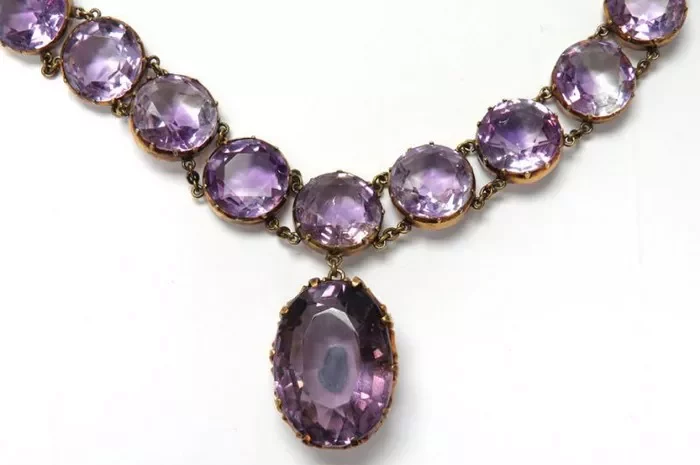Amethyst, a beautiful and mystical gemstone, has captivated the hearts of people for centuries. Its enchanting purple hue, derived from natural trace elements such as iron, manganese, and titanium, makes it a standout choice for jewelry. In this article, we will explore the various uses of amethyst in jewelry, its unique properties, and the cultural significance it holds.
The Properties of Amethyst
Amethyst is a variety of quartz, characterized by its deep purple coloration. This coloration is caused by the presence of trace amounts of iron and other impurities within the quartz crystal. The intensity of the purple hue can vary, ranging from a light lavender to a deep, almost blackish purple.
Physically, amethyst is a hard and durable gemstone, with a Mohs hardness of 7. This makes it suitable for use in jewelry, as it can withstand the wear and tear of daily use. However, like all gemstones, amethyst should still be handled with care to avoid scratches and damage.
Historical Significance
Amethyst has a rich and storied history, dating back to ancient civilizations. In ancient Greece, amethyst was believed to prevent intoxication and was worn by those who wished to avoid the effects of alcohol. It was also thought to have protective powers, warding off evil spirits and promoting calmness and clarity of thought.
Throughout history, amethyst has been a favored gemstone among royalty and the aristocracy. Its beautiful color and mystical properties made it a symbol of power, wealth, and status. Many royal families have included amethyst in their regalia and jewelry collections.
Uses in Jewelry
Rings
Rings are one of the most popular pieces of jewelry that incorporate amethyst. Whether it’s a simple solitaire ring or a more intricate design with additional gemstones, amethyst adds a touch of elegance and sophistication. Its deep purple hue complements both warm and cool skin tones, making it a versatile choice for anyone looking to add a pop of color to their outfit.
Pendants and Necklaces
Amethyst pendants and necklaces are another popular choice for jewelry enthusiasts. These pieces can range from simple and elegant designs to more intricate and ornate creations. Amethyst pendants often feature intricate carvings or designs that highlight the gemstone’s natural beauty. Necklaces, on the other hand, can be worn alone or layered with other necklaces to create a unique and personalized look.
Bracelets and Bangles
Amethyst bracelets and bangles are also a great way to showcase the gemstone’s beauty. These pieces can be made from a single strand of amethyst beads or combined with other gemstones and metals to create a more complex design. Bracelets and bangles are perfect for those who want to add a touch of color and sparkle to their wrists.
Earrings
Amethyst earrings are a fantastic choice for those who want to make a statement. Whether you prefer drop earrings, hoop earrings, or stud earrings, amethyst can add a pop of color and elegance to your look. Drop and hoop earrings can be particularly striking, as they allow the gemstone to dangle and sparkle with every movement.
Brooches and Pins
Amethyst brooches and pins are a wonderful way to add a touch of elegance to your outfit without being too overpowering. These pieces can be worn on lapels, hats, or scarves to add a hint of color and sophistication. Brooches and pins are also a great choice for those who want to wear jewelry but prefer something a little more subtle and understated.
Cultural Significance and Beliefs
In addition to its beauty and durability, amethyst holds significant cultural and spiritual meaning. In many cultures, amethyst is believed to have protective powers and can ward off negative energy. It is often associated with peace, calmness, and clarity of thought.
Many people also believe that amethyst can help to alleviate stress and anxiety. Its calming properties make it a popular choice for those who suffer from anxiety or stress-related disorders. Some people even wear amethyst jewelry during meditation or yoga sessions to help them achieve a deeper state of relaxation and focus.
In addition to its spiritual properties, amethyst is also believed to have healing properties. Some people believe that it can help to improve blood circulation, ease headaches, and even promote better sleep. While these beliefs may not be scientifically proven, they add to the allure and mystique of the gemstone.
Care and Maintenance
Like all gemstones, amethyst requires proper care and maintenance to keep it looking its best. Here are some tips for caring for your amethyst jewelry:
Store Separately: Amethyst can scratch other gemstones and metals, so it’s best to store it separately in a soft cloth or jewelry box.
Avoid Heat and Chemicals: Exposure to heat or chemicals can damage amethyst, so avoid exposing it to extreme temperatures or harsh chemicals.
Clean Gently: Use a soft cloth and warm water to gently clean your amethyst jewelry. Avoid using abrasive cleaners or scrubbing too hard, as this can scratch the gemstone.
Inspect Regularly: Regularly inspect your amethyst jewelry for any signs of damage or wear. If you notice any cracks or chips, take it to a jeweler for repair or replacement.
Conclusion
In conclusion, amethyst is a beautiful and mystical gemstone that has been used in jewelry for centuries. Its deep purple hue, durability, and cultural significance make it a popular choice for rings, pendants, necklaces, bracelets, earrings, and brooches. Whether you’re looking for a simple and elegant piece of jewelry or something more intricate and ornate, amethyst can add a touch of elegance and sophistication to your look. With proper care and maintenance, your amethyst jewelry will continue to shine and sparkle for years to come.
Related topic:
- What Is Brown Amethyst Stone
- Can You Shower with Amethyst Jewelry
- What Is the Benefits of Amethyst Stone


